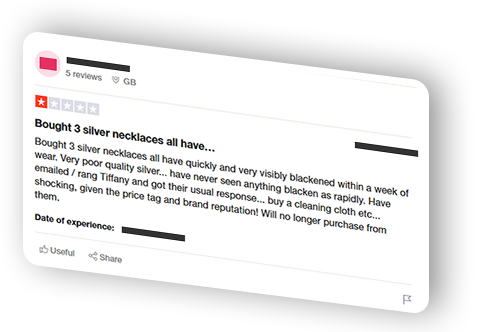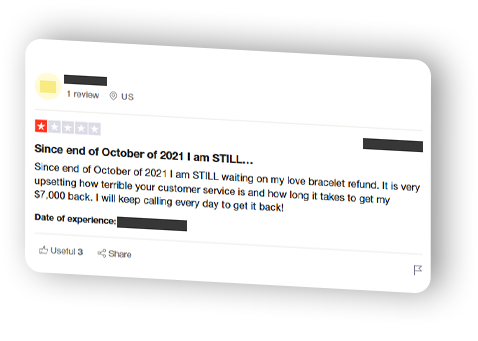 We recently launched a unique analysis. We reviewed online feedback from 50 jewelry retailers to find out why their customers are most dissatisfied. Of course, this isn’t a scientific study, so we’re not claiming these results apply to the entire jewelry retail market, but there are certainly lessons worth considering. Our research included big names like Tiffany, Cartier, and Catbird. We were surprised to see how many negative experiences came up, even with these major brands.
We recently launched a unique analysis. We reviewed online feedback from 50 jewelry retailers to find out why their customers are most dissatisfied. Of course, this isn’t a scientific study, so we’re not claiming these results apply to the entire jewelry retail market, but there are certainly lessons worth considering. Our research included big names like Tiffany, Cartier, and Catbird. We were surprised to see how many negative experiences came up, even with these major brands.
Let’s take a look at the most common complaints.
Common complaints in jewelry store reviews
Poor product quality
Many customers reported that the jewelry they purchased was of poor quality and often fell apart shortly after purchase. For instance, one customer mentioned a ring that required multiple repairs due to a “terrible design” that just wouldn’t last, leading to frustration and extra expenses for repeated repairs.
customer mentioned a ring that required multiple repairs due to a “terrible design” that just wouldn’t last, leading to frustration and extra expenses for repeated repairs.
Where can a retailer go wrong with product quality? We identified three main areas:
- The item is poorly designed from the start, so it's not a manufacturing problem.
- In-house manufacturing lacks sufficient attention to detail, possibly skipping essential QC checks (a good jewelry software can enforce mandatory QC points).
- With outsourced manufacturing, items from suppliers are not adequately inspected.
It’s crucial to focus on these aspects since the product is the heart of retail. Good customer service can't make up for a bad product.
Customer Service Issues
Numerous reviews highlighted negative customer service experiences. Customers described interactions with staff as rude or dismissive, particularly when they sought help with returns or repairs. One review mentioned a manager who was “bullying” and  unhelpful when a customer requested a partial refund for a defective item. Additionally, some customers complained about being ignored by staff in favor of more affluent-looking clients.
unhelpful when a customer requested a partial refund for a defective item. Additionally, some customers complained about being ignored by staff in favor of more affluent-looking clients.
These are serious concerns. We know how hard it is to find highly professional, customer-oriented employees. Establish clear policies for return and repair options, and train staff on how to communicate these policies effectively with clients.
As a business owner or manager, it’s essential to monitor how staff interact with customers. However, many managers are deeply involved in their administrative tasks, leaving little time for oversight. A software solution could streamline management tasks, freeing up valuable time to focus on customer service training.
Misleading product descriptions
“The necklace looks nothing like the picture.”
Customers frequently complained about receiving items that didn’t match descriptions or expectations. For example, one review mentioned rings that were supposed to be colored but arrived with clear stones instead, leading to disappointment and confusion over product authenticity.
items that didn’t match descriptions or expectations. For example, one review mentioned rings that were supposed to be colored but arrived with clear stones instead, leading to disappointment and confusion over product authenticity.
This is entirely under the retailer’s control and can be completely resolved. These issues often stem from a lack of organization within the company. For instance, the website may operate separately from the back-office system, so product details may not be updated in real-time.
PIRO helps organize a business’s daily operations, eliminating these simple but impactful errors that can tarnish the customer experience.
Problems with Returns and Refunds
Several reviewers expressed dissatisfaction with return policies and processes, citing issues such as poor communication about return statuses and difficulties in obtaining refunds for unsatisfactory products. One customer even threatened to initiate a chargeback due to the company’s failure to confirm the receipt of a returned item.
statuses and difficulties in obtaining refunds for unsatisfactory products. One customer even threatened to initiate a chargeback due to the company’s failure to confirm the receipt of a returned item.
Retailers often feel pressured to establish an online presence, which brings new shopping behaviors that must be addressed. When a customer orders jewelry, they’re placing trust in the retailer and expecting guarantees in return. Therefore, be transparent and generous in your return and refund policies, as bad reviews can discourage future buyers.
Inconsistent Availability and Stock Issues
Some reviews pointed out stock availability problems, where items ordered were either out of stock or took an excessively long time to process, leading to cancellations and customer dissatisfaction.
problems, where items ordered were either out of stock or took an excessively long time to process, leading to cancellations and customer dissatisfaction.
While not the biggest issue, it’s still important to address. This problem typically occurs when the website and back-office system are not synchronized. At PIRO, we strive to eliminate these issues entirely. For example, our Shopify plugin can update online stock every 30 seconds. So, if something is sold offline, it’s reflected online almost immediately.
Summary
We found that larger retailers are just as susceptible to mistakes as smaller ones. While it’s impossible to please every customer, paying close attention to customer satisfaction can help you provide an above-average customer experience. No one should settle for being average, right?
In some cases, greater attention to detail and more transparent policies can improve customer satisfaction. However, achieving this often depends on how organized the retail business is. Organization can only be achieved if your operations are supported and automated by the right jewelry software. PIRO Retail excels at this and stands out from other jewelry POS systems.
Interested? Contact us here for a consultation.





